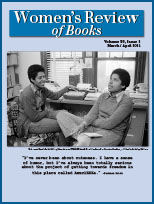Dear Readers,
 On one of my first days as the executive director of the Feminist Press, a dashing silver-haired woman swept into my office in red cowboy boots, jeans with a belt buckle John Wayne would have liked, patchwork vest, and a purple scarf. In an accent somehow both Southern and British, she said, “JEB. Darling, you do know JEB?”
On one of my first days as the executive director of the Feminist Press, a dashing silver-haired woman swept into my office in red cowboy boots, jeans with a belt buckle John Wayne would have liked, patchwork vest, and a purple scarf. In an accent somehow both Southern and British, she said, “JEB. Darling, you do know JEB?”
My interlocutor was Blanche Wiesen Cook, the radical feminist raconteur and celebrated Eleanor Roosevelt biographer. Also: one of the coolest people I've ever met. JEB (Joan E. Biren) was (and is) her friend and the photographer who, since the mid-1970s, photographed lesbians in their natural environments—with friends, taking care of kids, kissing a girlfriend, fixing cars at a womyn-run garage. At Blanche’s urging, I checked out JEB’s work, which bristles with era-specific action and aesthetics. These weren’t images I saw often, and I had a thought of creating something people would look at every day: a planner or journal, peppered with dozens of photos of, for instance, a shirtless woman sawing a 2x4 on a deck, her latissimus dorsi as taut as the board. I wanted to call the journal Womyn’s Studies. Drew, the art director, mocked up a gorgeous layout.
With a sense of missed opportunity, I unearthed Womyn’s Studies from my desktop a few days ago, after reading a new edition of JEB’s Eye to Eye: Portraits of Lesbians, published by Anthology Editions. (The original was self-published in 1979 and distributed through the then-robust network of feminist bookstores, lesbian and gay bookstores, and mail order.)
Living in DC a few years after graduating from Mount Holyoke in 1966, JEB helped found the Furies Collective, a lesbian feminist separatist commune named after the avenging goddesses of Greek mythology. As the Furies disbanded, the members fanned out to found organizations like Olivia Records and the Center for Women’s Global Leadership. JEB, meanwhile, noticed that even during the post- sexual revolution, post-Stonewall height of second wave feminism, images of lesbians were scarce. “I had never seen a picture of two women kissing and I wanted to see it,” she recounts in the book. “I borrowed a camera, but I didn’t even know anybody else I could ask to pose for it. So I held the camera out at arm’s length and kissed my lover, Sharon, and took the picture. That’s my first lesbian photograph.”
From that moment, JEB chronicled lesbian life. The portrait on the cover was taken at legendary publisher, writer, and activist Barbara Smith’s home in Roxbury, Mass. A few years earlier Barbara and her twin sister Beverly were two of the cofounders of the foundational Black feminist organization the Combahee River Collective. Barbara went on to teach, co-found Kitchen Table: Women of Color Press, and to this day continues to write and organize.
Barbara attended Mount Holyoke around the same time JEB did, although they became friends through the women’s movement. I asked Barbara why Eye to Eye was groundbreaking, and she began by describing the actively anti-lesbian culture of 1970s America. “JEB was making us visible at a time when lesbians were absolutely marginalized,” she said. “Now, it’s cute to be a lesbian. It’s actually cute. You can have a multimillion-dollar career. You can have a nightly television show. You can be a movie star or make films yourself. You can be Black. You can even sell Russell Stover chocolates,” she added, laughing. Barbara was referring to a recent holiday ad featuring all sorts of people offering chocolate to their loved ones. It ends with a lesbian couple in a tight embrace. “Whenever I see that commercial, to my eyes, it’s just like, ‘I’m not really seeing this.’ But there’s a reason that lesbians can be in a commercial for candy, and it’s called having built a movement.”
The photos were for the community, not the mainstream, but JEB’s photographs are cropping up in “establishment” spaces, too. In 2019, for instance, the New York Times ran a glowing appraisal of JEB’s work and she received the 2018 Alice Austen Award for Advancement in Photography. For Barbara Smith, this constituted another Russell Stover moment: “[For] those of us who have known JEB for decades and been involved in the same kind of efforts to gain visibility and rights, the coverage in the New York Times was like, ‘Wow. So now they’re paying attention.’”
As Paula Gunn Allen has written, the root of oppression is loss of memory. JEB's rich trove of images preserves lesbian history and counters the amnesia necessary for patriarchal culture. Barbara, too, has dedicated her life to creating space for lesbian feminists to be visible, read, and heard. She advocates that we read the groundbreaking feminists in their own words. (The Library of America has collected many of the most influential pieces in the new Women’s Liberation: Feminist Writing that Inspired a Revolution & Still Can. On page 15, you'll find details for attending their celebratory event, at which Barbara will be speaking.) “You can’t find out about our history by scanning social media—you just can’t,” she said. “You’ve got to dig in if you want to know where you came from.”
Jennifer Baumgardner,
February 18, 2021
New York, New York

